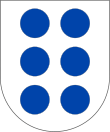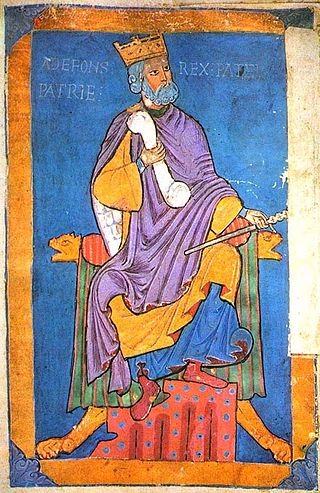
Alfonso VI, nicknamed the Brave or the Valiant, was king of León (1065–1109), Galicia (1071–1109), and Castile (1072–1109).

Blanche of Portugal, was an infanta, the firstborn child of King Afonso III of Portugal and his second wife Beatrice of Castile. Named after her great-aunt Blanche of Castile, queen of France, Blanche was the Lady of Las Huelgas, Montemor-o-Velho, Alcocer and Briviesca, the city which she founded.
Muniadona of Castile, also called Mayor or Munia, was Queen of Pamplona by her marriage with King Sancho Garcés III, who later added to his domains the Counties of Ribagorza (1017) and Castile (1028) using her dynastic rights to these territories.
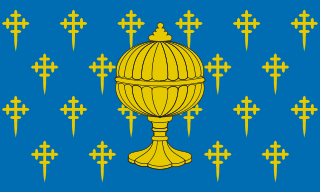
The Kingdom of Galicia was a political entity located in southwestern Europe, which at its territorial zenith occupied the entire northwest of the Iberian Peninsula. It was founded by the Suebic king Hermeric in 409, with its capital established in Braga. It was the first kingdom that officially adopted Catholicism. In 449, it minted its own currency. In 585, it became a part of the Visigothic Kingdom. In the 8th century, Galicia became a part of the newly founded Christian Kingdom of Asturias, which later became the Kingdom of León, while occasionally achieving independence under the authority of its own kings. Compostela became the capital of Galicia in the 11th century, while the independence of Portugal (1128) determined its southern boundary. The accession of Castilian King Ferdinand III to the Leonese kingdom in 1230 brought Galicia under the control of the Crown of Castile.

García Fernández, called of the White Hands, was the count of Castile and Alava from 970 to 995. In May 995, he was captured by a raiding party while out hunting. Wounded in the encounter, he was sent to Cordoba as a trophy, but died at Medinaceli in June 995.
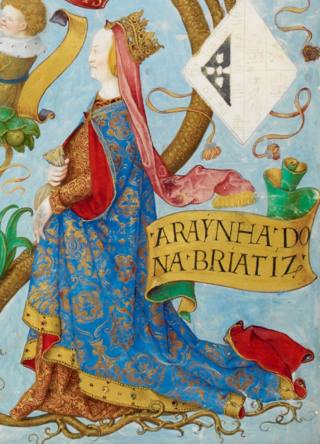
Beatrice of Castile, an illegitimate daughter of Alfonso X of Castile and his mistress Mayor Guillén de Guzmán, was the second Queen consort of Afonso III of Portugal.

Fernando Ruiz de Castro, was a Galician nobleman of the House of Castro and prominent military figure. He was the third Count of Lemos, Trastámara and Sarria. He is often referred to by the appellation "Toda la lealtad de España", from an inscription on his tomb in Bayonne.

Pedro Fernández de Castro, nicknamed el de la Guerra, was a powerful Galician noble and military figure of the House of Castro, descended by illegitimate lines from the kings of Castile-Leon-Galicia. Pedro Fernandez de Castro was Lord (Señor) of Lemos and Sarria and served as mayordomo mayor of Alfonso XI of Castile, adelantado de la frontera (governor) of Andalusia, Galicia and Murcia and pertiguero mayor of the lands of Santiago.
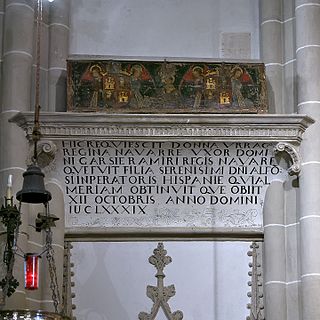
Urraca Alfonso, also known as Urraca the Asturian, illegitimate daughter of Alfonso VII of León, was Queen Consort of Navarre by her marriage to García Ramírez. After becoming a widow, she returned to her homeland and was the regent of Asturias from 1153 to 1165. Urraca was involved in a rebellion against her half-brother, King Ferdinand II of León and with her second husband, Álvaro Rodríguez de Castro attempted to secure the independence of Asturias.
Stephanie Alfonso of Castile was an illegitimate daughter of Alfonso VII of León and Castile and Urraca Fernández de Castro, widow of Count Rodrigo Martínez, who was Urraca's cousin or uncle. Her murder by her husband, Fernando Rodríguez de Castro, earned her the sobriquet Stephanie the Unfortunate.
Pedro Fernández de Castro, also known as Pedro Fernández de Fuentecalada, was the first Grand Master of the Order of Santiago and the founder of the Monastery of Santa Cruz de Valcárcel. He was a Spanish nobleman and a member of the House of Castro.
Bermudo Ovéquiz was a member of the highest ranks of the nobility of Asturias, León, and Galicia who lived in the 11th century.

Rodrigo Fernández de Castro, called the Bald, was a Castilian nobleman and soldier. One of the founders of the House of Castro, he was the second son of Fernando García de Hita and Tegridia, sister or aunt of Count Rodrigo Martínez and relative of the Ansúrez family. His paternal grandfather may have been García Ordóñez, who died at the battle of Uclés in 1108.
Pedro Rodríguez de Castro, second son of Rodrigo Fernández de Castro the bald and Eylo Álvarez, daughter of Álvar Fáñez, and of the Countess Mayor Perez, was a Castilian nobleman of the lineage of the Castro. Just like his great-grandfather, count Pedro Ansúrez, he was Butler of Leon in 1184 and tenente of Grado, Tineo, Pravia, and Limia. The Count of Barcelos in his Nobiliario, and Argote de Molina in his nobility of Andalusia, called him "the monk" as he entered religion after becoming a widower.
Fernando García de Hita was a Castilian nobleman, traditionally considered the founder of the noble House of Castro. He governed the lordships of Hita and Guadalajara, and frequently attended the royal court under King Alfonso VI and Queen Urraca.
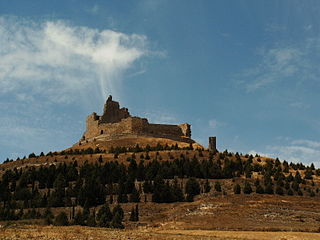
Gutierre Fernández de Castro was a nobleman and military commander from the Kingdom of Castile. His career in royal service corresponds exactly with the reigns of Alfonso VII (1126–57) and his son Sancho III (1157–58). He served Alfonso as a courtier after 1134 and as majordomo (1135–38). He was the guardian and tutor the young Sancho III from 1145. Before his death he was also briefly the guardian of Sancho's infant son, Alfonso VIII.

Gutierre Rodríguez de Castro also known as Gutierre Ruiz de Castro and nicknamed el Escalabrado was a Castilian nobleman, member of the House of Castro as the son of Rodrigo Fernández de Castro and his wife Elo Álvarez, daughter of Álvar Fáñez and his wife Mayor Pérez, daughter of Count Pedro Ansúrez.
Sancho Ordóñez, was a count who lived in the 11th century. His father was Ordoño Bermúdez, an illegitimate son of King Bermudo II of León, and his mother was Fronilde Peláez, also a member of the high nobility as the daughter of Count Pelayo Rodríguez and his wife Gotina Fernández de Cea, daughter of Count Fernando Bermúdez de Cea and sister of Jimena, the mother of King Sancho Garcés III the Great, and of Justa Fernández, married to Count Flaín Muñoz.
The Banu Gómez were a powerful but fractious noble family living on the Castilian marches of the Kingdom of León from the 10th to the 12th centuries. They rose to prominence in the 10th century as counts in Saldaña, Carrión and Liébana, and reached their apogee when, allied with Córdoba warlord, Almanzor, their head, García Gómez, expelled king Vermudo II of León and briefly ruled there. He would reconcile with the royal family, but launched two subsequent rebellions. On his death, the senior line of the family was eclipsed, but a younger branch would return to prominence, producing Pedro Ansúrez, one of the premier noblemen under king Alfonso VI and queen Urraca in the late 11th and early 12th centuries. The family would be portrayed in the Cantar de Mio Cid as rivals and antagonists of the hero, El Cid, and their rebellions would serve as a basis for the legend of Bernardo del Carpio.
Violante Sánchez of Castile, was a Castilian noblewoman and by marriage Lady of Lemos, Sarria, Cabrera and Ribera.
